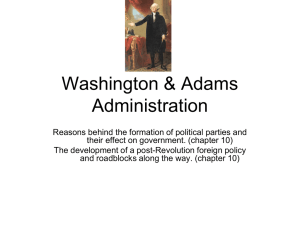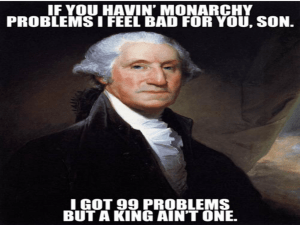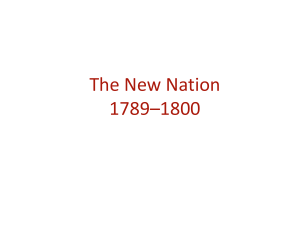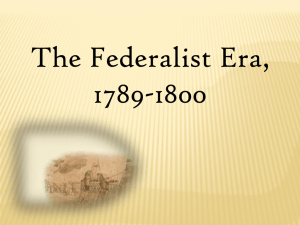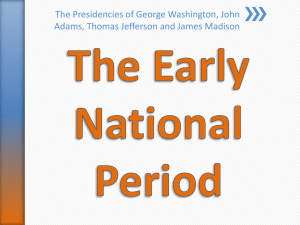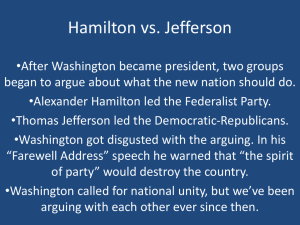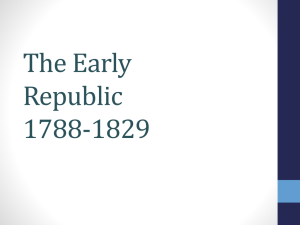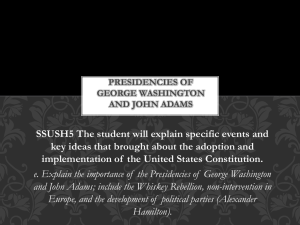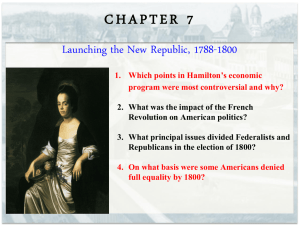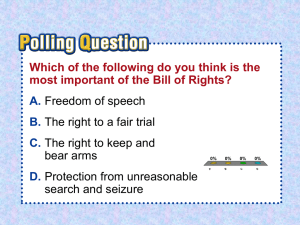A New Nation Outline
advertisement
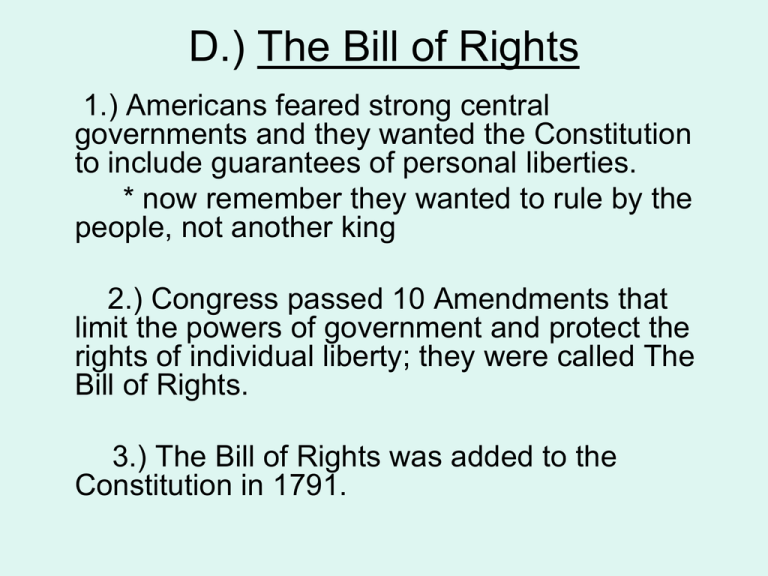
D.) The Bill of Rights 1.) Americans feared strong central governments and they wanted the Constitution to include guarantees of personal liberties. * now remember they wanted to rule by the people, not another king 2.) Congress passed 10 Amendments that limit the powers of government and protect the rights of individual liberty; they were called The Bill of Rights. 3.) The Bill of Rights was added to the Constitution in 1791. II. Financial Problems A. The National Debt 1.) The national debt is the amount of money that the U.S. government owes. B. Hamilton’s Plan 1.) The Secretary of the Treasury, Alexander Hamilton, wanted to pay off the national debt the money owed by the Confederation government to other countries and to individual American citizens. * The only time the U.S. bill were paid and there was no national debt was with Alexander Hamilton after his plan was passed by George Washington and Congress 2.) Alexander Hamilton believed that since the states had fought for the nations independence in the Revolutionary War, that the nation / the federal government should pay the states back for the cost of their help. He believed that if the nation / the federal government paid the states’ debts that the states would want the success of the national government. C.) Opposition to the Plan 1.) Congress agreed to pay back the money that the U.S. owed to other nations that helped the U.S in the American Revolution. (i.e. France) 2.) When the government borrowed money during the American Revolution, it had issued bonds - paper notes promising to repay the money in a certain amount of time – to regular people such as; shopkeepers, farmers and soldiers. 3.) Many people who bought the bonds got impatient waiting for the bonds to be repaid, so they sold them to speculators – people who risk money to make a big profit – so the speculators would be the ones to get repaid under Hamilton’s plan, and this made the original bond holders mad. 4.) The Southern states were not happy with Hamilton’s plan because they had accumulated less debt than the northern states and they complained that they would have to pay more than their share. * Every state would have to pay the same amount of money to pay back the bonds 5.) People liked Hamilton’s plan to pay back nations but they didn’t like his plan to pay back states. * Mostly the South didn’t like it because they felt that they had little invested in the bonds so they shouldn’t have to repay them D.) Compromise results in a Capital 1.) To win support for his plan, Hamilton agreed to a proposal from the Southern leaders to move the capital of the United States to the South – it was moved to a special district between Virginia and Maryland along the banks of the Potomac River. It became Washington D.C. *The land was donated by Virginia and Maryland so that the capitol could be on neutral ground. This is why Washington is; Washington in the District of Columbia – Washington D.C. is not a state—so the government can not favor the people of one state or another. Compare with: FOR or AGAINST ISSUES NATIONAL BANK PROECTIVE TARIFF NATIONAL TAXES HAMILTON JEFFERSON III Building the Economy • Alexander Hamilton wanted to build a strong national economy. He asked congress to create a national bank and call it The Bank of the United States. This Bank Still exists today. A) The Fight Over the Bank 1) In 1792 there were only 8 other banks in the U.S. and they were states banks. 2) Madison and Jefferson said the bank was unconstitutional-that the Constitution had no provisions creating such an institution. 3) The president (George Washington) agreed with Hamilton and signed the bill creating the National Bank. B) Tariffs and Taxes 1) At the time most Americans were farmers. 2) Alexander Hamilton thought that the development of manufacturing (factories) would make America’s economy stronger. 3) Hamilton proposed a tariff- a tax on imports-to encourage people to buy American products and protect American industry from foreign competition. *An example would be buying silk from China and furniture from Europe. *Hamilton said buy American 4) Hamilton did not get support for the protective tariffs because the South did not have a lot of industry and opposed the protective tariff, but he won support in Congress for some low tariffs to raise money. 5) By the 1790’s the revenue-money-from tariffs provided 90% of the national governments income. 6) Alexander Hamilton’s economic program gave the government new financial powers, but split the Congress and the people of the U.S. because there were many people including Thomas Jefferson and James Madison who feared a national government with strong economic powers that was dominated by the wealthy class. • U.S. needed a stronger national government than they previously had with the Articles of Confederation • Constitution gave foundation for a strong national government • Too strong~ like a king • Too little authority~ no control • They wanted the people of the U.S. to have an equal say in the money and politics of the U.S. --Democracy • Thomas Jefferson was afraid that a neutral government with strong economic powers that was run/dominated by the wealthy class would not consider the poor and middle class people or treat them fairly in being taxed Pg. 262 Analyzing Primary Sources Hamilton said about Washington, “He consulted much, pondered much, resolved slowly, resolved surely.” Question: Did this make Washington a good first president? Explain. Section 2: EARLY CHALLENGES • Neutrality- a position of not taking sides in a conflict • Impressment- forcing people into service, as into the navy • Surplus-extra,excess • Barter-trade,exchange Whiskey Rebellion • Hamilton’s taxes led to rebellion in Western Pennsylvania – Surplus of corn – Produce Whiskey from corn – Live off of bartering – Taxed – How could they pay when they had no cash? Peaceful resistance until 1794 -Federal officers began to make a greater effort to collect the taxes -People resisted -Tax collectors were attacked with pitchforks, guns, swords, etc… -Tax collectors houses were burned down • Government leaders became alarmed at the armed protest • Washington and his advisors sent and army to crush the rebellion • This action placed new procedures into play How to handle disagreement… “Washington served notice to those who opposed government actions. If citizens wished to change the law, they had to do so peacefully, through constitutional means. Government would use force when necessary to maintain the social order.” p264 THINK????? How did the Whiskey Rebellion affect the way government handled protesters? Struggle Over the West • Native Americans living between the Appalachian Mountains and the Mississippi River said that the U.S. had no authority over them. • Turn to pg. RA3 in front of book—put your finger on the space between the Appalachian Mountains an the Mississippi River-----• Catskills, NY~ Poconos, N.J. PA ~ Adirondacks, upstate NY ~ Blue Ridge Mountains VA……All part of the Appalachian Mountains • Turn to pg. RA6 to see what was ours ( the United States in 1787) • Great Britain and Spain helped the Native Americans go against the United States because Great Britain and Spain wanted to settle the Northwest territory • Washington signed treaties with the Native American tribes to weaken the influence of Great Britain and Spain • Washington did his best to stop the Native Americans from running to Spain and Great Britain for help. • American settlers ignored treaties and moved onto the lands that had been promised to the Native Americans • Fighting broke out between the groups • Washington sent an army under General Arthur St. Clair to restore order in the Northwest territory. • The British still had forts in the region an they wanted to keep their profitable fur trade • The British were worried that the French would help the Americans and in 1794 the British told the Native Americans to destroy American settlements west of the Appalacians. Battle of Fallen Timbers • The Native Americans demanded that all settlers north of the Ohio river leave the territory • Washington sent an army, led by General Anthony Wayne, to challenge their demands and in August 1794 his army defeated over 1,000 Native Americans at the Battle of Fallen Timbers • As a result of the Battle of Fallen Timbers, the U.S. and the Native Americans signed a treaty, The Treaty of Greenville, in 1795, in which the Native Americans agreed to give most of the land in present day Ohio to the United States. Problems with Europe • The French Revolution began in 1789 and because the French had helped the Americans in the American Revolution many people in America were happy for the French-they compared it to the American Revolution • By 1793 the French Revolution turned bloody when leaders of the revolution executed the King and Queen of France along with thousands of French citizens • The violence in the French Revolution, it’s attack on religion and attack on individual liberties offended many Americans and public opinion in the Unites States started to dividenothing like the American Revolution • Britain and France went to war in 1793 • Some Americans, mainly in the south sympathized with France • Some Americans, especially manufacturers and merchants, who traded with the British favored the British • Hamilton, Adams and their supporters were pro-British, but Jefferson was proFrench, because he thought that if the French won, that it would help drive the British out of America • George Washington wanted the nation to stay neutral and not take sides Washington Proclaims Neutrality • In April 1793 the French sent a diplomat, Edmond Genet to the United States to recruit American volunteers to attack British ships • On April 22 George in Washington issued a proclamation of neutrality that forbid American citizens from fighting the war and barred French and British warships from American ports • A few hundred Americans signed up to serve on French ships before Washington’s proclamation of neutrality • The French ships with Americans on them seized British ships and stole their cargoes, (before Washington closed the American ports) and because of this the British became enraged and started capturing American ships that traded with the French. They sometimes forced their crews to join the British Navy (this is called impressment) • Impressment infuriated Americans, and combined with the British and Indian challenge in the West, pushed America closer to war with Great Britain Controversial Treaty • President Washington sent John Jay, Chief Justice of the supreme court, to negotiate a treaty with Great Britain. • The British were willing to listen to Jay’s proposal, because war with the United States would make it harder to carry on the war with France and the United States was Britain’s best market for trade • In Jay’s Treaty the British agreed to leave America, to pay damages for ships they had seized, and to allow some American ships to trade with British colonies in the Caribbean • The treaty allowed for debts from before 1776 to be settled • Not many Americans liked Jay’s treaty because it did not deal with impressment and it did not deal with interference with American trade Treaty With Spain • In 1795 Thomas Pinckney went to Spain to make a treaty with them • Pinckney’s treaty allowed Americans to travel the Mississippi freely and the right to trade at the port of New Orleans. Washington’s Farewell • Washington set a precedent by choosing to serve only two terms • Washington left office, afraid of the growth of political parties and U.S. involvement in foreign affairs • Washington’s opinions can be summed up in the quote on pg. 266 I. The First Political Parties A. Opposing Views 1) Americans today call George Washington, ‘America’s Greatest Leader’, but during his two terms there were harsh attacks on his policies and his personality in newspapers. 2) By 1796 Americans were beginning to divide into political parties. 3) Hamilton and Jefferson often took opposing sides on political issues. 4) Washington usually supported Hamilton B. Political Parties emerge 1) By the mid-1790’s two distinct political parties had emerged 2) The parties were the Federalist and DemocraticRepublicans 3) The Federalist stood for a strong central government 4) The Democratic-Republicans wanted to limit government’s power 5) The Federalists: admired the British and distrusted the French; favored banking and shipping interests; had strong support in the Northeast, especially New England, and from wealthy plantation owners in the South. 6) The Democratic-Republicans: supported the French; their supporters were small farmers and urban workers, especially in the Middle Atlantic states and the South. C. Views on the Constitution 1) Hamilton believed in a more liberal interpretation of ‘implied’ powers than Jefferson and Madison. 2) Hamilton believed that the ‘implied powers’ were those powers not expressively forbidden by the Constitution. 3) Jefferson and Madison believed that ‘implied powers’ should only be used to carry out the expressed powers of the Constitution. D. The People’s Role 1) The Federalists supported representative government 2) The Democratic-Republicans supported a direct government E. Washington’s Dilemma 1) Washington respected both Hamilton and Jefferson, and he tried to get them to work together. 2) In 1793 Hamilton resigned as Secretary of the Treasury and Jefferson resigned as the Secretary of State. F. The Election of 1796 1) The presidential election of 1796 was the first one where candidates for office came from different parties. 2) The Federalists and the (Democratic) Republicans held meetings called caucuses to elect the candidate from their party. 3) John Adams and Charles Pinckney ran for president and vice-president for the Federalists 4) Thomas Jefferson and Aaron Burr ran for president and vice-president for the Republicans 5) The man with the highest number of votes won the presidency, and the man with the second highest number of votes won the vice-presidency, and so John Adams was elected president and Thomas Jefferson was elected vice-president. II. President John Adams REMEMBER: John Adams was an active patriot and former ambassador to France and Great Britain. He helped to negotiate The Treaty of Paris that ended the American Revolution and he served two terms under president George Washington as vice-president. A. The XYZ Affair 1) REMEMBER: The French thought that ‘Jay’s Treaty’ of 1794, was an American to attempt to help the British in the war with France, so they were seizing American ships that carried British cargo. 2) Adams wanted to avoid war with France so he sent a delegation to Paris to try to work out a compromise. 3) The French foreign minister, Charles de Talleyrand, refused to meet with the Americans and instead he sent three agents who demanded a bribe and a loan for France from Americans. 4) John Adams was furious and he told Congress to prepare for war. 5) The incident became known as The XYZ Affair. B. Undeclared War With France 1) In response, in 1798, Congress established the Navy Department, set aside money for building warships, and increased the size of the army. 2) Congress appointed George Washington as the commanding general. 3) United States and France vessels clashed between 1798 and 1800. 4) War was never formally declared, but in 1800 John Adams’ America and France made an agreement that ensured peace. 5) REMEMBER: The Republican party previously supported France and they were reluctant to turn on them, so in the election of 1798 many Republicans were voted out of office.
